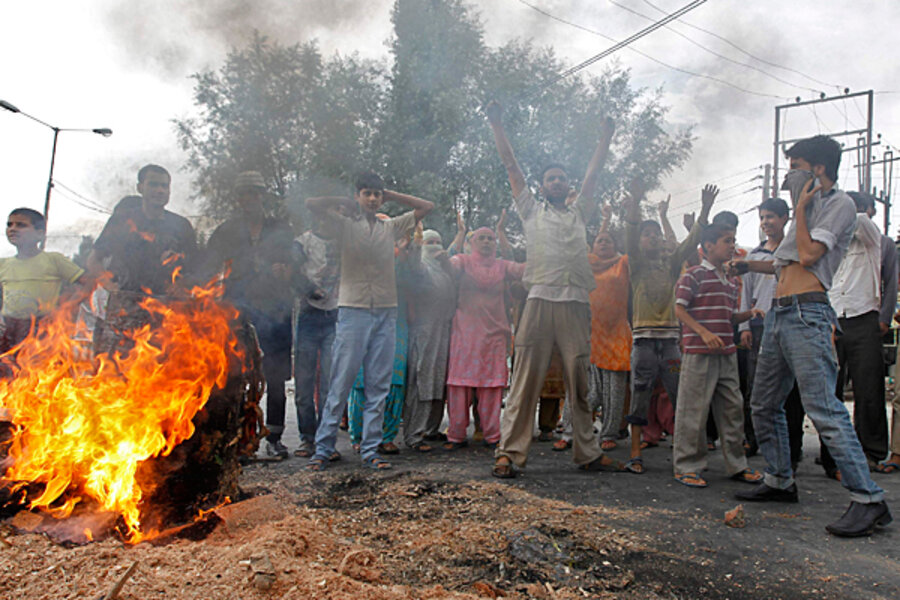India sends more troops to quell Kashmir protests
Loading...
| Srinagar and New Delhi, India
At least eight more protesters in Kashmir died in clashes with police Monday and Tuesday, prompting the Indian government to dispatch more forces to the region.
New Delhi ordered 1,900 new central paramilitary forces to quell the Kashmir protests, according to Indian media reports Tuesday. Another 3,200 paramilitary police already in Jammu and Kashmir State will be redeployed to centers of separatist unrest in the Kashmir Valley, reports said.
The state, with a population of 10 million, already has an estimated 700,000 security forces, giving it an extremely high (70:1,000) force to population ratio. Gen. David Petraeus’s counterinsurgency manual says experts recommend ratios close to 25:1,000, something the US has never met in Afghanistan.
Many Kashmiris complain bitterly about the heavy security presence, and tensions have risen in the past month as Indian forces have repeatedly fired on rock-throwing youth and peaceful protesters. Four people were killed Tuesday when protesters defied a curfew and marched in Srinigar, according to reports, bringing the death toll to at least 45 over the past seven weeks of street clashes.
Some analysts in New Delhi argue more forces are needed – but more who are trained in nonlethal crowd control.
“What is being done is more and more of the same force is being sent in. What we need is more people being equipped in crowd control without firing,” says Ajai Sahni, executive director of the Institute for Conflict Management in New Delhi.
The Indian Army deployed in the state is not engaged in the current standoff between police and separatist-minded protesters, but is focused on defending the Line of Control against Pakistan. Even without the Army in the streets, places like the main city of Srinagar – where groups of police and rifle-toting paramilitaries stand at many street corners – feel more militarized than villages being held by US Marines in Afghanistan’s Helmand Province.
Order first, politics second
By sending in additional forces, India is hoping to restore order before sorting out a political process for redressing Kashmiri grievances. “Tragically, we have locked ourselves into a cycle of violence where protest leads to death, leading to further protests and further casualties,” Omar Abdullah, the chief minister of Jammu and Kashmir State, told reporters Monday. “We have to break that cycle.”
Mr. Omar also stressed that “a political package more than an economic package” was needed. In this he seems to be at odds with his seniors in New Delhi, including Sonia Gandhi, the leader of India’s ruling National Congress Party, who called for “a continued push on the development agenda.”
The additional forces might allay some of the fatigue expressed by rank-and-file police, who talk about 17-hour shifts on “emergency” days. And police leaders in Kashmir do mention the need for a jobs program targeted at former militants and returnees from Pakistani training camps.
Yet none of the six rock-throwing youths that the Monitor recently interviewed were unemployed, and they vigorously denied that the source of youth frustration was economic. Rather, they pointed to heavy-handed police tactics and a prevailing desire for India to quit Kashmir.
Shakeel Qalander, president of the Federation Chamber of Industries Kashmir, puts unemployment in the valley at about 10 percent. “It may be a factor, but largely I don’t think this is responsible for stone pelting. The political alienation is the reason for stone pelting,” he says.
The economic cost of the unrest
The unrest is taking an undeniable economic toll on residents, however. Mr. Qalander estimates the loss at 1 billion rupees ($21.6 million) a day for “all segments of enterprises and businesses we have in the valley.”
The business community is “sandwiched” between the orders of the government and the orders of the separatists, he says. “Whenever the government issues curfews, we have to abide by that. Whenever a separatist organization calls for a shutdown, we have to abide by that.”
Day laborers feel the brunt of such shutdowns. Residents have mobilized neighborhood committees, centered around the mosque but not directed by religious leaders, to distribute donations to Kashmiris suffering privation from the loss of work.
Related:





